Algebra Problems: Simplifying, Solving, and Graphing
VerifiedAdded on 2020/11/23
|17
|2400
|302
Homework Assignment
AI Summary
This algebra assignment presents solutions to a variety of problems covering fundamental concepts. The assignment begins with simplifying radical expressions and solving radical equations, followed by finding the domain of functions and solving exponential equations. It also includes problems on exponents, logarithms, rational expressions, and systems of equations. Additionally, the assignment covers graphing quadratic functions, determining intercepts, vertex, and solving for x-axis interception points. Finally, the assignment concludes with graphing piecewise functions and solving miscellaneous algebra problems. The solutions are detailed and step-by-step, offering a comprehensive guide to understanding and solving the presented algebraic challenges. This resource is designed to assist students in grasping key algebraic concepts and improving their problem-solving skills.
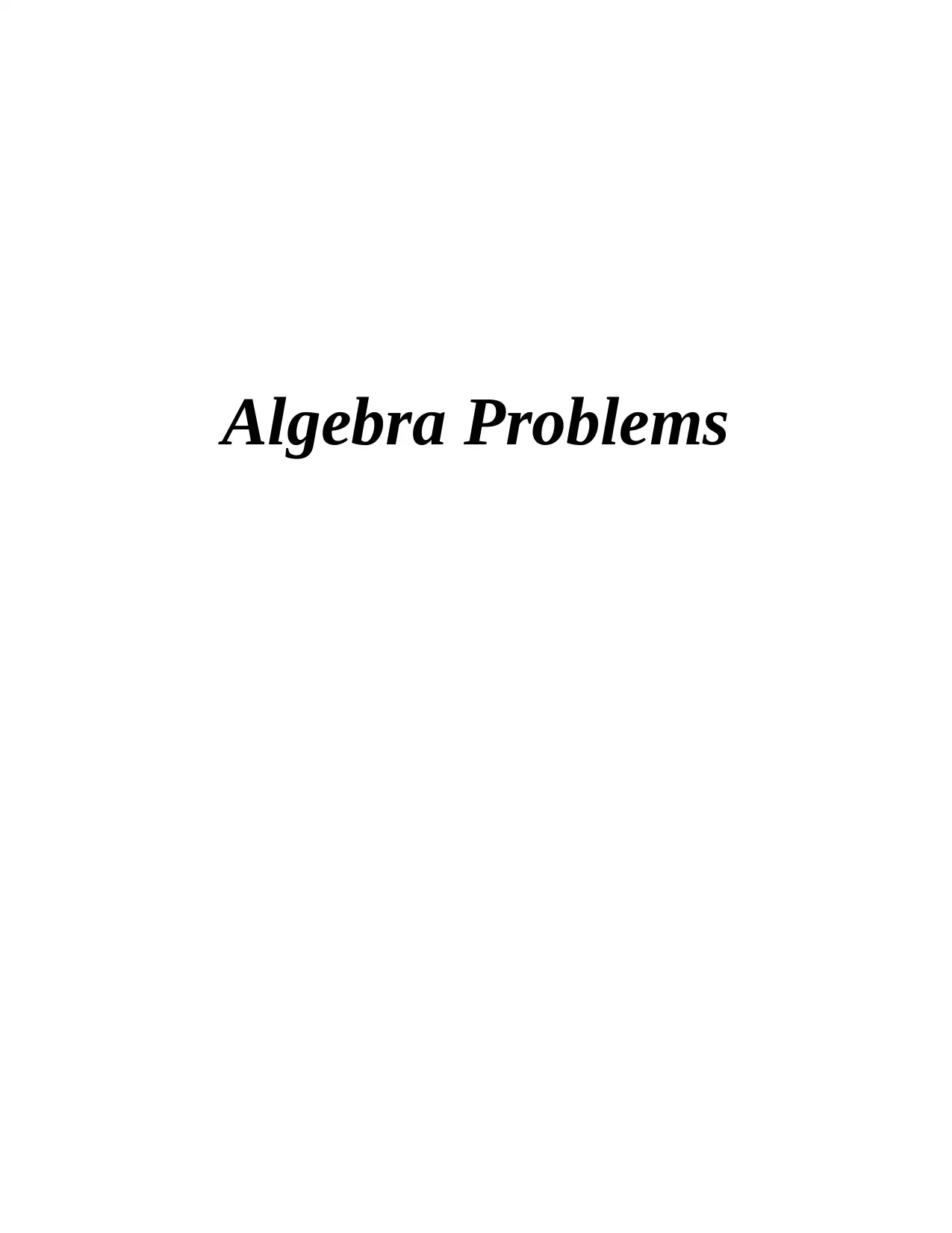
Algebra Problems
Paraphrase This Document
Need a fresh take? Get an instant paraphrase of this document with our AI Paraphraser

Q1. Simplify the questions??
a). 2√128
Ans: √{27}
√{26.2}
23 √{2}
=8 √{2}
b). √{9 a8}b3
Ans: √{9}√{a8}
3√{a8}
= 3a {8}/{2}}
= 3 a4 b3
C). 3√{24 a4}b8
Ans: 2[3]√3 b8 a{{4}/{3}}
d). √{{75}/{a6}}
Ans: √{52. 3}
√{3}√{52}
{5√{3}}/{a3}
e) {5}/√{7}}
Ans: frac5√{7}√{7}√{7}}
{5√{7}}/{7}
f).{3 y}√{4-{7}}
Ans: {3 y}/{4-√{7}}={(4+√{7})y}/{3}
3 y(4+√7)/(4-√7)(4+√7) : Multiply by the conjugate
(4-V7)(4+V7)= 9
= 3(4+V7)y/9
= (4+V7)y/3
a). 2√128
Ans: √{27}
√{26.2}
23 √{2}
=8 √{2}
b). √{9 a8}b3
Ans: √{9}√{a8}
3√{a8}
= 3a {8}/{2}}
= 3 a4 b3
C). 3√{24 a4}b8
Ans: 2[3]√3 b8 a{{4}/{3}}
d). √{{75}/{a6}}
Ans: √{52. 3}
√{3}√{52}
{5√{3}}/{a3}
e) {5}/√{7}}
Ans: frac5√{7}√{7}√{7}}
{5√{7}}/{7}
f).{3 y}√{4-{7}}
Ans: {3 y}/{4-√{7}}={(4+√{7})y}/{3}
3 y(4+√7)/(4-√7)(4+√7) : Multiply by the conjugate
(4-V7)(4+V7)= 9
= 3(4+V7)y/9
= (4+V7)y/3
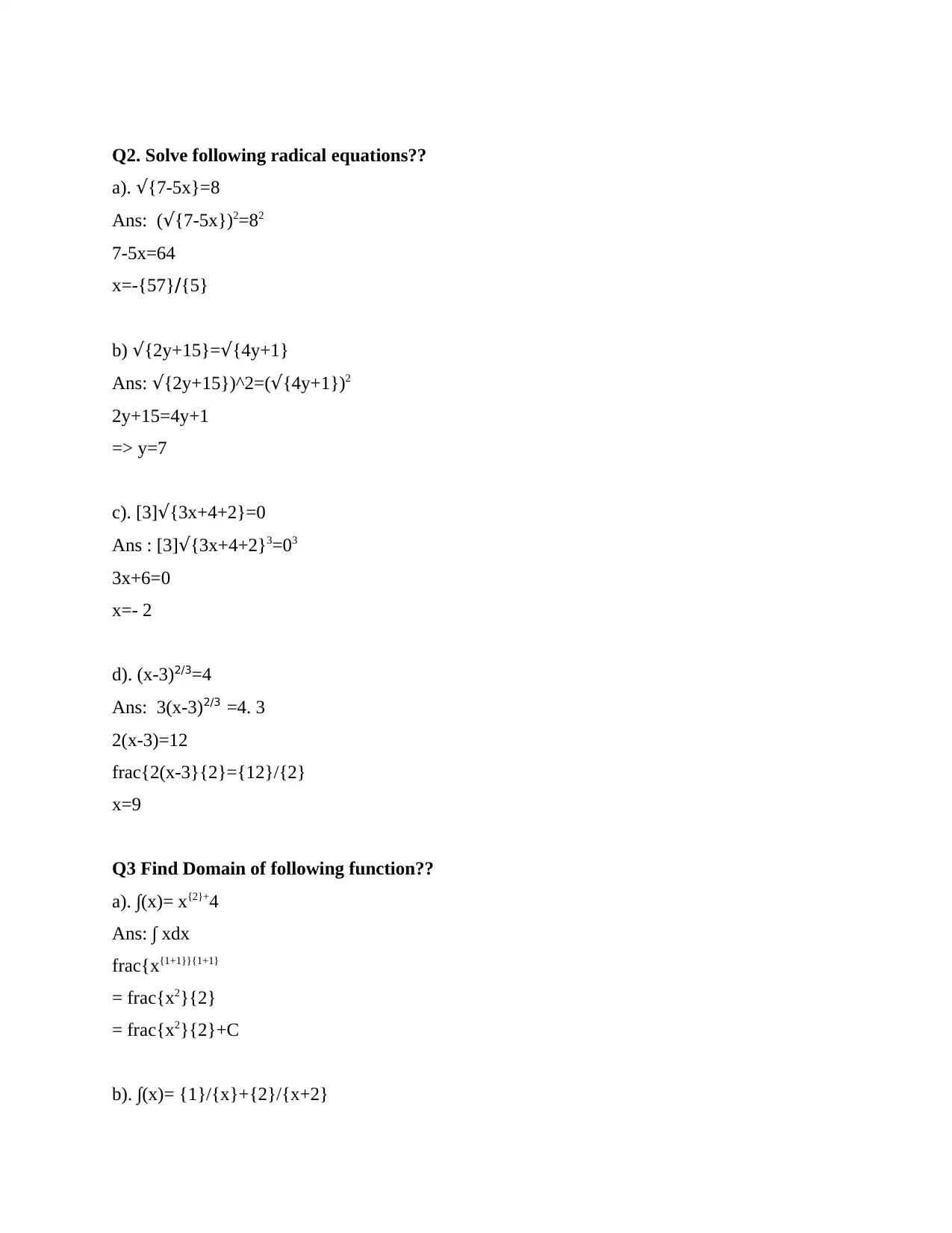
Q2. Solve following radical equations??
a). √{7-5x}=8
Ans: (√{7-5x})2=82
7-5x=64
x=-{57}/{5}
b) √{2y+15}=√{4y+1}
Ans: √{2y+15})^2=(√{4y+1})2
2y+15=4y+1
=> y=7
c). [3]√{3x+4+2}=0
Ans : [3]√{3x+4+2}3=03
3x+6=0
x=- 2
d). (x-3)2/3=4
Ans: 3(x-3)2/3 =4. 3
2(x-3)=12
frac{2(x-3}{2}={12}/{2}
x=9
Q3 Find Domain of following function??
a). ∫(x)= x{2}+4
Ans: ∫ xdx
frac{x{1+1}}{1+1}
= frac{x2}{2}
= frac{x2}{2}+C
b). ∫(x)= {1}/{x}+{2}/{x+2}
a). √{7-5x}=8
Ans: (√{7-5x})2=82
7-5x=64
x=-{57}/{5}
b) √{2y+15}=√{4y+1}
Ans: √{2y+15})^2=(√{4y+1})2
2y+15=4y+1
=> y=7
c). [3]√{3x+4+2}=0
Ans : [3]√{3x+4+2}3=03
3x+6=0
x=- 2
d). (x-3)2/3=4
Ans: 3(x-3)2/3 =4. 3
2(x-3)=12
frac{2(x-3}{2}={12}/{2}
x=9
Q3 Find Domain of following function??
a). ∫(x)= x{2}+4
Ans: ∫ xdx
frac{x{1+1}}{1+1}
= frac{x2}{2}
= frac{x2}{2}+C
b). ∫(x)= {1}/{x}+{2}/{x+2}
⊘ This is a preview!⊘
Do you want full access?
Subscribe today to unlock all pages.

Trusted by 1+ million students worldwide
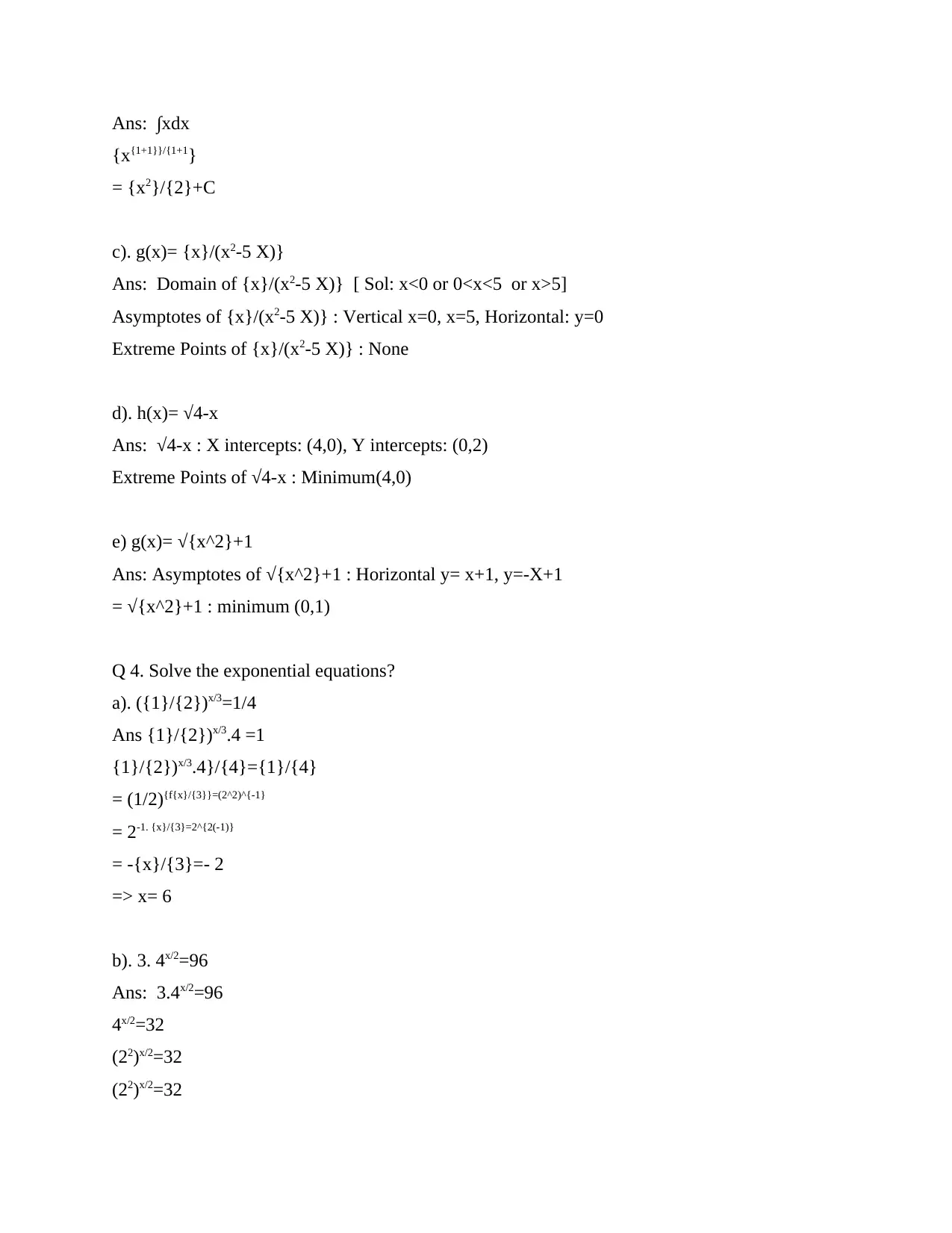
Ans: ∫xdx
{x{1+1}}/{1+1}
= {x2}/{2}+C
c). g(x)= {x}/(x2-5 X)}
Ans: Domain of {x}/(x2-5 X)} [ Sol: x<0 or 0<x<5 or x>5]
Asymptotes of {x}/(x2-5 X)} : Vertical x=0, x=5, Horizontal: y=0
Extreme Points of {x}/(x2-5 X)} : None
d). h(x)= √4-x
Ans: √4-x : X intercepts: (4,0), Y intercepts: (0,2)
Extreme Points of √4-x : Minimum(4,0)
e) g(x)= √{x^2}+1
Ans: Asymptotes of √{x^2}+1 : Horizontal y= x+1, y=-X+1
= √{x^2}+1 : minimum (0,1)
Q 4. Solve the exponential equations?
a). ({1}/{2})x/3=1/4
Ans {1}/{2})x/3.4 =1
{1}/{2})x/3.4}/{4}={1}/{4}
= (1/2){f{x}/{3}}=(2^2)^{-1}
= 2-1. {x}/{3}=2^{2(-1)}
= -{x}/{3}=- 2
=> x= 6
b). 3. 4x/2=96
Ans: 3.4x/2=96
4x/2=32
(22)x/2=32
(22)x/2=32
{x{1+1}}/{1+1}
= {x2}/{2}+C
c). g(x)= {x}/(x2-5 X)}
Ans: Domain of {x}/(x2-5 X)} [ Sol: x<0 or 0<x<5 or x>5]
Asymptotes of {x}/(x2-5 X)} : Vertical x=0, x=5, Horizontal: y=0
Extreme Points of {x}/(x2-5 X)} : None
d). h(x)= √4-x
Ans: √4-x : X intercepts: (4,0), Y intercepts: (0,2)
Extreme Points of √4-x : Minimum(4,0)
e) g(x)= √{x^2}+1
Ans: Asymptotes of √{x^2}+1 : Horizontal y= x+1, y=-X+1
= √{x^2}+1 : minimum (0,1)
Q 4. Solve the exponential equations?
a). ({1}/{2})x/3=1/4
Ans {1}/{2})x/3.4 =1
{1}/{2})x/3.4}/{4}={1}/{4}
= (1/2){f{x}/{3}}=(2^2)^{-1}
= 2-1. {x}/{3}=2^{2(-1)}
= -{x}/{3}=- 2
=> x= 6
b). 3. 4x/2=96
Ans: 3.4x/2=96
4x/2=32
(22)x/2=32
(22)x/2=32
Paraphrase This Document
Need a fresh take? Get an instant paraphrase of this document with our AI Paraphraser
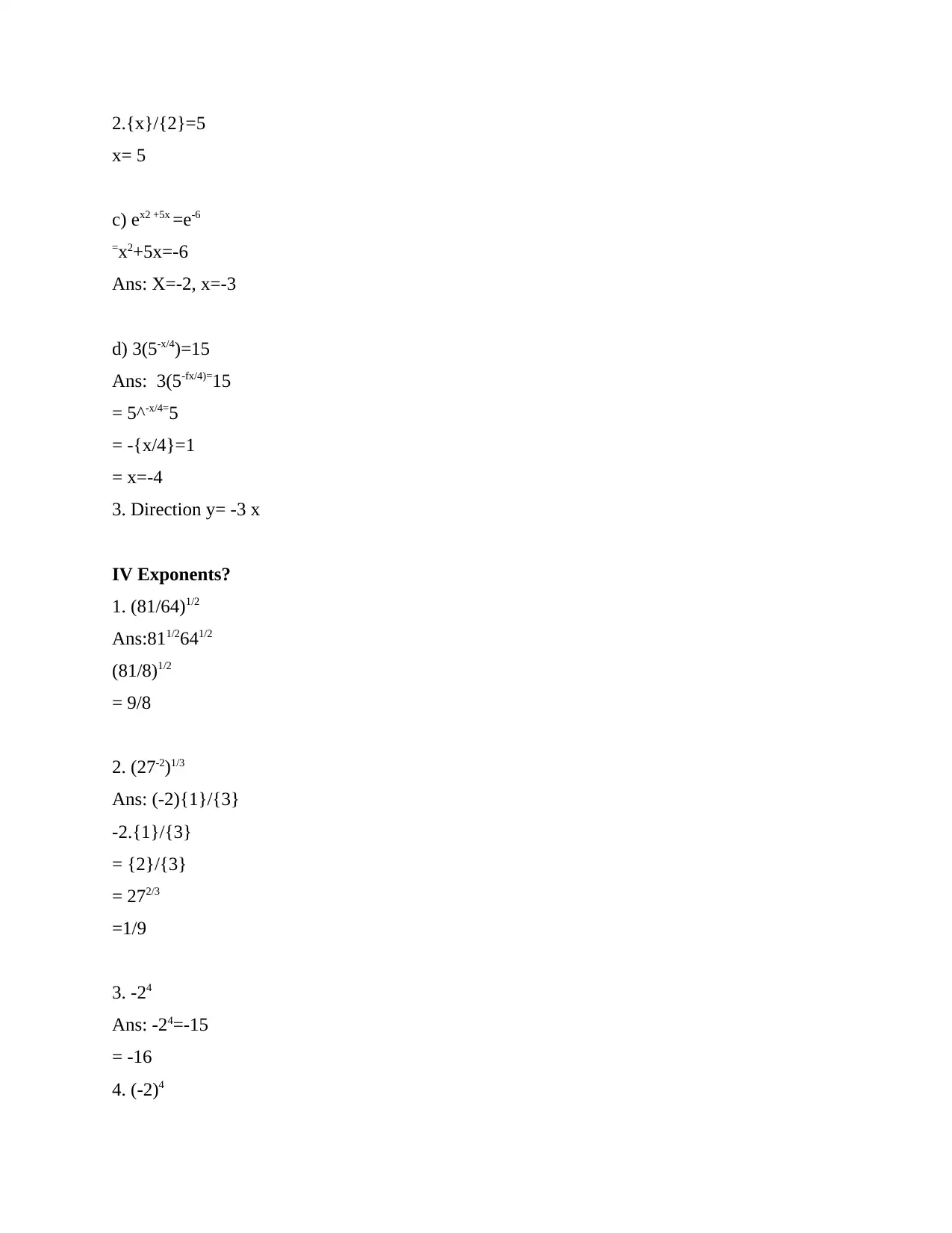
2.{x}/{2}=5
x= 5
c) ex2 +5x =e-6
=x2+5x=-6
Ans: X=-2, x=-3
d) 3(5-x/4)=15
Ans: 3(5-fx/4)=15
= 5^-x/4=5
= -{x/4}=1
= x=-4
3. Direction y= -3 x
IV Exponents?
1. (81/64)1/2
Ans:811/2641/2
(81/8)1/2
= 9/8
2. (27-2)1/3
Ans: (-2){1}/{3}
-2.{1}/{3}
= {2}/{3}
= 272/3
=1/9
3. -24
Ans: -24=-15
= -16
4. (-2)4
x= 5
c) ex2 +5x =e-6
=x2+5x=-6
Ans: X=-2, x=-3
d) 3(5-x/4)=15
Ans: 3(5-fx/4)=15
= 5^-x/4=5
= -{x/4}=1
= x=-4
3. Direction y= -3 x
IV Exponents?
1. (81/64)1/2
Ans:811/2641/2
(81/8)1/2
= 9/8
2. (27-2)1/3
Ans: (-2){1}/{3}
-2.{1}/{3}
= {2}/{3}
= 272/3
=1/9
3. -24
Ans: -24=-15
= -16
4. (-2)4
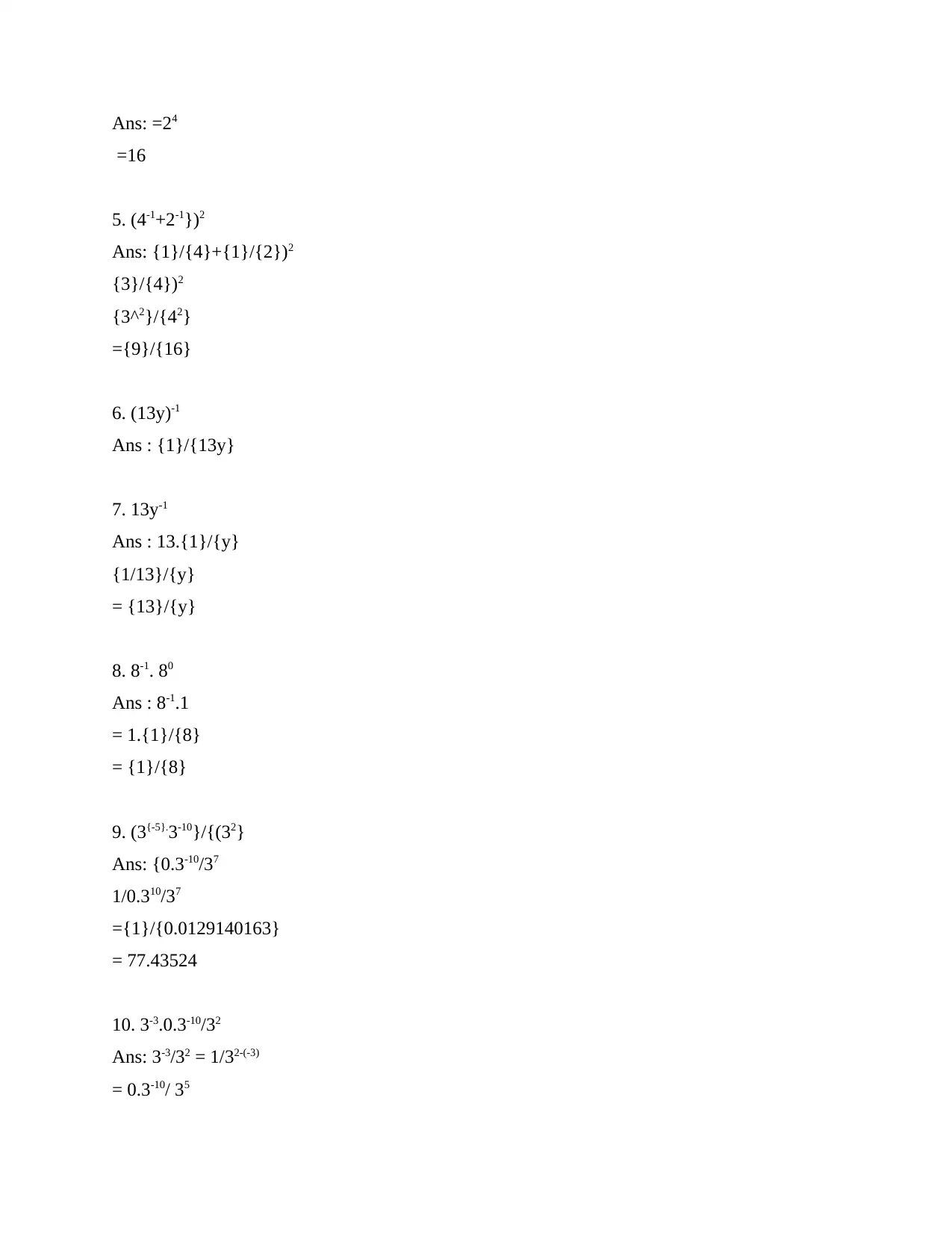
Ans: =24
=16
5. (4-1+2-1})2
Ans: {1}/{4}+{1}/{2})2
{3}/{4})2
{3^2}/{42}
={9}/{16}
6. (13y)-1
Ans : {1}/{13y}
7. 13y-1
Ans : 13.{1}/{y}
{1/13}/{y}
= {13}/{y}
8. 8-1. 80
Ans : 8-1.1
= 1.{1}/{8}
= {1}/{8}
9. (3{-5}.3-10}/{(32}
Ans: {0.3-10/37
1/0.310/37
={1}/{0.0129140163}
= 77.43524
10. 3-3.0.3-10/32
Ans: 3-3/32 = 1/32-(-3)
= 0.3-10/ 35
=16
5. (4-1+2-1})2
Ans: {1}/{4}+{1}/{2})2
{3}/{4})2
{3^2}/{42}
={9}/{16}
6. (13y)-1
Ans : {1}/{13y}
7. 13y-1
Ans : 13.{1}/{y}
{1/13}/{y}
= {13}/{y}
8. 8-1. 80
Ans : 8-1.1
= 1.{1}/{8}
= {1}/{8}
9. (3{-5}.3-10}/{(32}
Ans: {0.3-10/37
1/0.310/37
={1}/{0.0129140163}
= 77.43524
10. 3-3.0.3-10/32
Ans: 3-3/32 = 1/32-(-3)
= 0.3-10/ 35
⊘ This is a preview!⊘
Do you want full access?
Subscribe today to unlock all pages.

Trusted by 1+ million students worldwide

=0.3-10/35 : Apply exponent rule : xa/xb = 1/xb-a
= 1/35. 0.310
= 1/0.0014348907
= 696.91719
V.Logarithms
i. Factor and cancel
1. 3log2x=12
=3log2(x)/3= 12/3 (divide both sides by 3)
=log2(x)= 4
Apply rule a= logb (bª)
4= log2(24)= log2(16)
Log2(x)= log2(16)
x=16
2. log5125=x
x= log5125
x= log5 (53)
Apply rule loga(xb )= b.loga(x)
x= log5(53)= 3log5(5)
x= 3log5(5)
Apply rule: loga(a)=1
x=3*1
x=3
3. 3+4logx4=5
= 3+4logx(4)=5
= 3+4logx(4)-3=5-3 (subtract bith sides by 3)
= 4logx(4)=2
= 4logx(4)/4=2/4 (divide both sides by 4)
= logx(4)= 1/2
= 1/35. 0.310
= 1/0.0014348907
= 696.91719
V.Logarithms
i. Factor and cancel
1. 3log2x=12
=3log2(x)/3= 12/3 (divide both sides by 3)
=log2(x)= 4
Apply rule a= logb (bª)
4= log2(24)= log2(16)
Log2(x)= log2(16)
x=16
2. log5125=x
x= log5125
x= log5 (53)
Apply rule loga(xb )= b.loga(x)
x= log5(53)= 3log5(5)
x= 3log5(5)
Apply rule: loga(a)=1
x=3*1
x=3
3. 3+4logx4=5
= 3+4logx(4)=5
= 3+4logx(4)-3=5-3 (subtract bith sides by 3)
= 4logx(4)=2
= 4logx(4)/4=2/4 (divide both sides by 4)
= logx(4)= 1/2
Paraphrase This Document
Need a fresh take? Get an instant paraphrase of this document with our AI Paraphraser
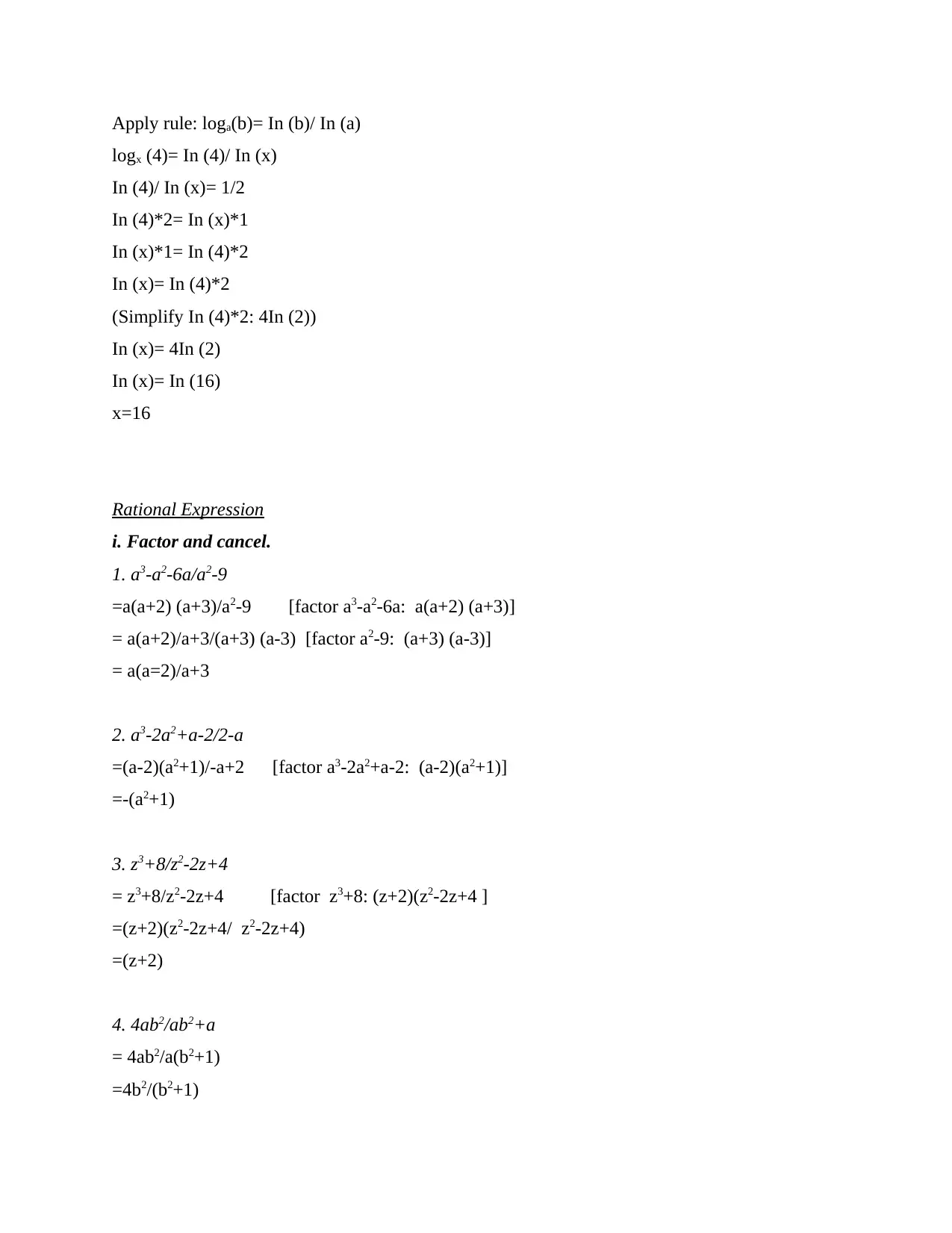
Apply rule: loga(b)= In (b)/ In (a)
logx (4)= In (4)/ In (x)
In (4)/ In (x)= 1/2
In (4)*2= In (x)*1
In (x)*1= In (4)*2
In (x)= In (4)*2
(Simplify In (4)*2: 4In (2))
In (x)= 4In (2)
In (x)= In (16)
x=16
Rational Expression
i. Factor and cancel.
1. a3-a2-6a/a2-9
=a(a+2) (a+3)/a2-9 [factor a3-a2-6a: a(a+2) (a+3)]
= a(a+2)/a+3/(a+3) (a-3) [factor a2-9: (a+3) (a-3)]
= a(a=2)/a+3
2. a3-2a2+a-2/2-a
=(a-2)(a2+1)/-a+2 [factor a3-2a2+a-2: (a-2)(a2+1)]
=-(a2+1)
3. z3+8/z2-2z+4
= z3+8/z2-2z+4 [factor z3+8: (z+2)(z2-2z+4 ]
=(z+2)(z2-2z+4/ z2-2z+4)
=(z+2)
4. 4ab2/ab2+a
= 4ab2/a(b2+1)
=4b2/(b2+1)
logx (4)= In (4)/ In (x)
In (4)/ In (x)= 1/2
In (4)*2= In (x)*1
In (x)*1= In (4)*2
In (x)= In (4)*2
(Simplify In (4)*2: 4In (2))
In (x)= 4In (2)
In (x)= In (16)
x=16
Rational Expression
i. Factor and cancel.
1. a3-a2-6a/a2-9
=a(a+2) (a+3)/a2-9 [factor a3-a2-6a: a(a+2) (a+3)]
= a(a+2)/a+3/(a+3) (a-3) [factor a2-9: (a+3) (a-3)]
= a(a=2)/a+3
2. a3-2a2+a-2/2-a
=(a-2)(a2+1)/-a+2 [factor a3-2a2+a-2: (a-2)(a2+1)]
=-(a2+1)
3. z3+8/z2-2z+4
= z3+8/z2-2z+4 [factor z3+8: (z+2)(z2-2z+4 ]
=(z+2)(z2-2z+4/ z2-2z+4)
=(z+2)
4. 4ab2/ab2+a
= 4ab2/a(b2+1)
=4b2/(b2+1)
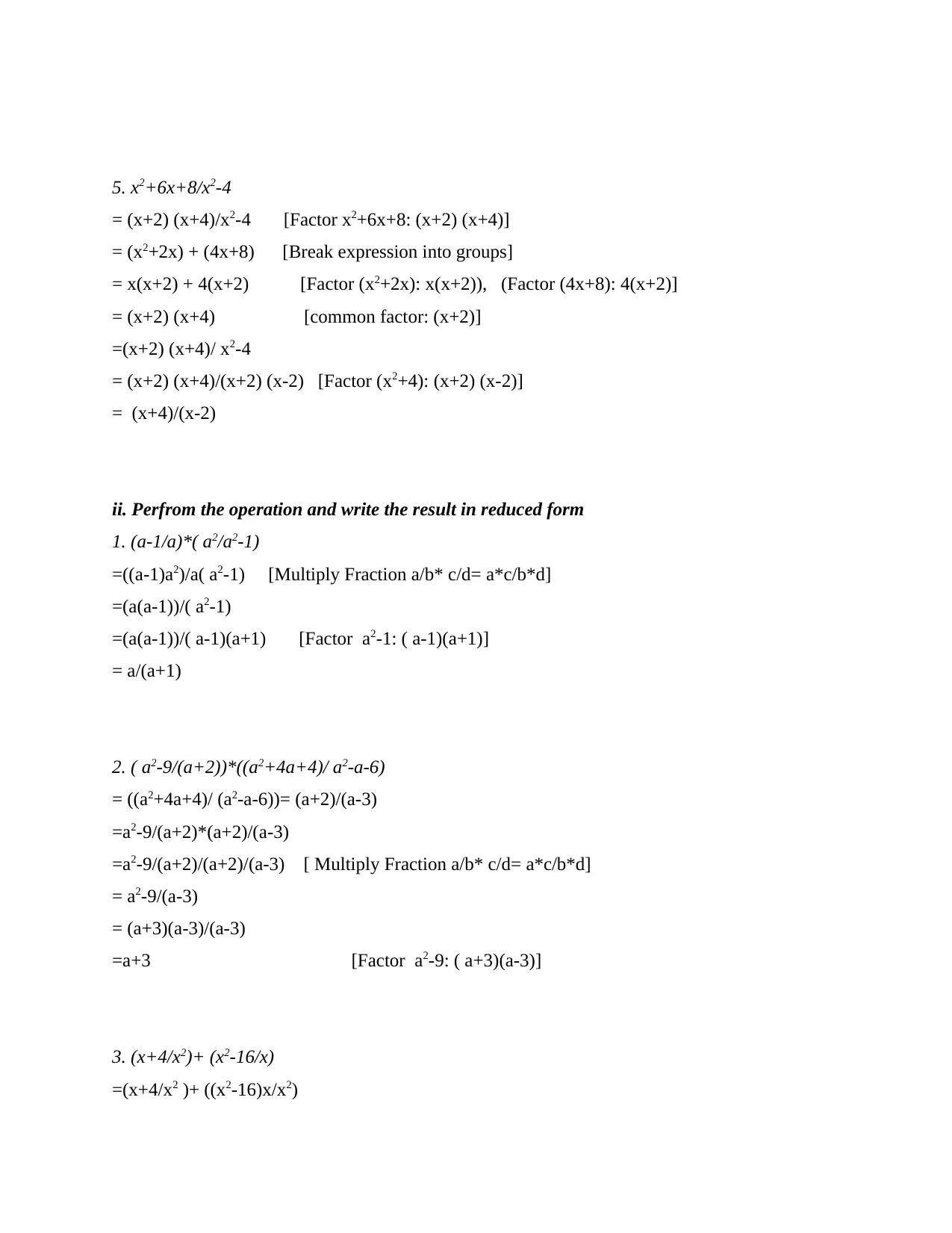
5. x2+6x+8/x2-4
= (x+2) (x+4)/x2-4 [Factor x2+6x+8: (x+2) (x+4)]
= (x2+2x) + (4x+8) [Break expression into groups]
= x(x+2) + 4(x+2) [Factor (x2+2x): x(x+2)), (Factor (4x+8): 4(x+2)]
= (x+2) (x+4) [common factor: (x+2)]
=(x+2) (x+4)/ x2-4
= (x+2) (x+4)/(x+2) (x-2) [Factor (x2+4): (x+2) (x-2)]
= (x+4)/(x-2)
ii. Perfrom the operation and write the result in reduced form
1. (a-1/a)*( a2/a2-1)
=((a-1)a2)/a( a2-1) [Multiply Fraction a/b* c/d= a*c/b*d]
=(a(a-1))/( a2-1)
=(a(a-1))/( a-1)(a+1) [Factor a2-1: ( a-1)(a+1)]
= a/(a+1)
2. ( a2-9/(a+2))*((a2+4a+4)/ a2-a-6)
= ((a2+4a+4)/ (a2-a-6))= (a+2)/(a-3)
=a2-9/(a+2)*(a+2)/(a-3)
=a2-9/(a+2)/(a+2)/(a-3) [ Multiply Fraction a/b* c/d= a*c/b*d]
= a2-9/(a-3)
= (a+3)(a-3)/(a-3)
=a+3 [Factor a2-9: ( a+3)(a-3)]
3. (x+4/x2)+ (x2-16/x)
=(x+4/x2 )+ ((x2-16)x/x2)
= (x+2) (x+4)/x2-4 [Factor x2+6x+8: (x+2) (x+4)]
= (x2+2x) + (4x+8) [Break expression into groups]
= x(x+2) + 4(x+2) [Factor (x2+2x): x(x+2)), (Factor (4x+8): 4(x+2)]
= (x+2) (x+4) [common factor: (x+2)]
=(x+2) (x+4)/ x2-4
= (x+2) (x+4)/(x+2) (x-2) [Factor (x2+4): (x+2) (x-2)]
= (x+4)/(x-2)
ii. Perfrom the operation and write the result in reduced form
1. (a-1/a)*( a2/a2-1)
=((a-1)a2)/a( a2-1) [Multiply Fraction a/b* c/d= a*c/b*d]
=(a(a-1))/( a2-1)
=(a(a-1))/( a-1)(a+1) [Factor a2-1: ( a-1)(a+1)]
= a/(a+1)
2. ( a2-9/(a+2))*((a2+4a+4)/ a2-a-6)
= ((a2+4a+4)/ (a2-a-6))= (a+2)/(a-3)
=a2-9/(a+2)*(a+2)/(a-3)
=a2-9/(a+2)/(a+2)/(a-3) [ Multiply Fraction a/b* c/d= a*c/b*d]
= a2-9/(a-3)
= (a+3)(a-3)/(a-3)
=a+3 [Factor a2-9: ( a+3)(a-3)]
3. (x+4/x2)+ (x2-16/x)
=(x+4/x2 )+ ((x2-16)x/x2)
⊘ This is a preview!⊘
Do you want full access?
Subscribe today to unlock all pages.

Trusted by 1+ million students worldwide
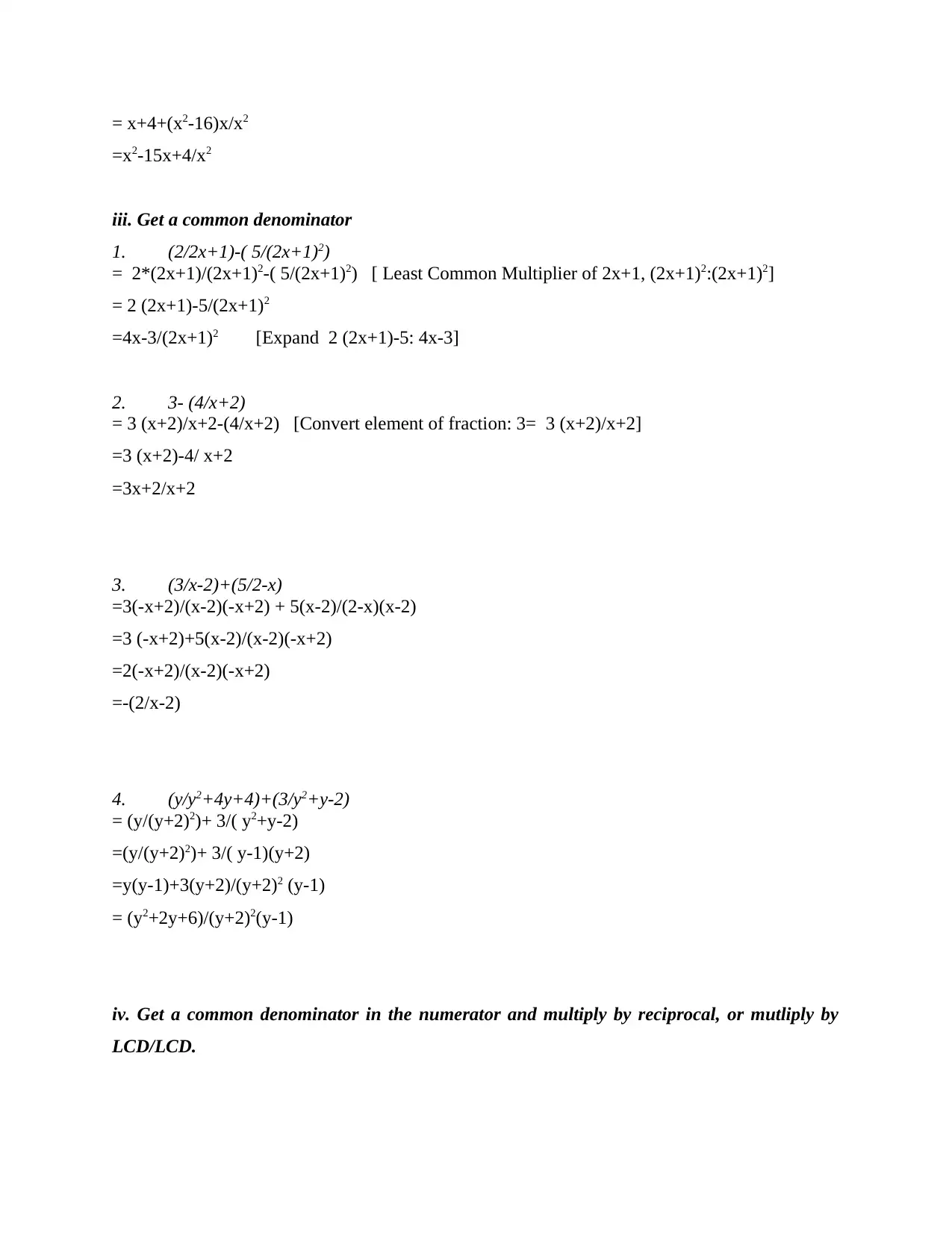
= x+4+(x2-16)x/x2
=x2-15x+4/x2
iii. Get a common denominator
1. (2/2x+1)-( 5/(2x+1)2)
= 2*(2x+1)/(2x+1)2-( 5/(2x+1)2) [ Least Common Multiplier of 2x+1, (2x+1)2:(2x+1)2]
= 2 (2x+1)-5/(2x+1)2
=4x-3/(2x+1)2 [Expand 2 (2x+1)-5: 4x-3]
2. 3- (4/x+2)
= 3 (x+2)/x+2-(4/x+2) [Convert element of fraction: 3= 3 (x+2)/x+2]
=3 (x+2)-4/ x+2
=3x+2/x+2
3. (3/x-2)+(5/2-x)
=3(-x+2)/(x-2)(-x+2) + 5(x-2)/(2-x)(x-2)
=3 (-x+2)+5(x-2)/(x-2)(-x+2)
=2(-x+2)/(x-2)(-x+2)
=-(2/x-2)
4. (y/y2+4y+4)+(3/y2+y-2)
= (y/(y+2)2)+ 3/( y2+y-2)
=(y/(y+2)2)+ 3/( y-1)(y+2)
=y(y-1)+3(y+2)/(y+2)2 (y-1)
= (y2+2y+6)/(y+2)2(y-1)
iv. Get a common denominator in the numerator and multiply by reciprocal, or mutliply by
LCD/LCD.
=x2-15x+4/x2
iii. Get a common denominator
1. (2/2x+1)-( 5/(2x+1)2)
= 2*(2x+1)/(2x+1)2-( 5/(2x+1)2) [ Least Common Multiplier of 2x+1, (2x+1)2:(2x+1)2]
= 2 (2x+1)-5/(2x+1)2
=4x-3/(2x+1)2 [Expand 2 (2x+1)-5: 4x-3]
2. 3- (4/x+2)
= 3 (x+2)/x+2-(4/x+2) [Convert element of fraction: 3= 3 (x+2)/x+2]
=3 (x+2)-4/ x+2
=3x+2/x+2
3. (3/x-2)+(5/2-x)
=3(-x+2)/(x-2)(-x+2) + 5(x-2)/(2-x)(x-2)
=3 (-x+2)+5(x-2)/(x-2)(-x+2)
=2(-x+2)/(x-2)(-x+2)
=-(2/x-2)
4. (y/y2+4y+4)+(3/y2+y-2)
= (y/(y+2)2)+ 3/( y2+y-2)
=(y/(y+2)2)+ 3/( y-1)(y+2)
=y(y-1)+3(y+2)/(y+2)2 (y-1)
= (y2+2y+6)/(y+2)2(y-1)
iv. Get a common denominator in the numerator and multiply by reciprocal, or mutliply by
LCD/LCD.
Paraphrase This Document
Need a fresh take? Get an instant paraphrase of this document with our AI Paraphraser
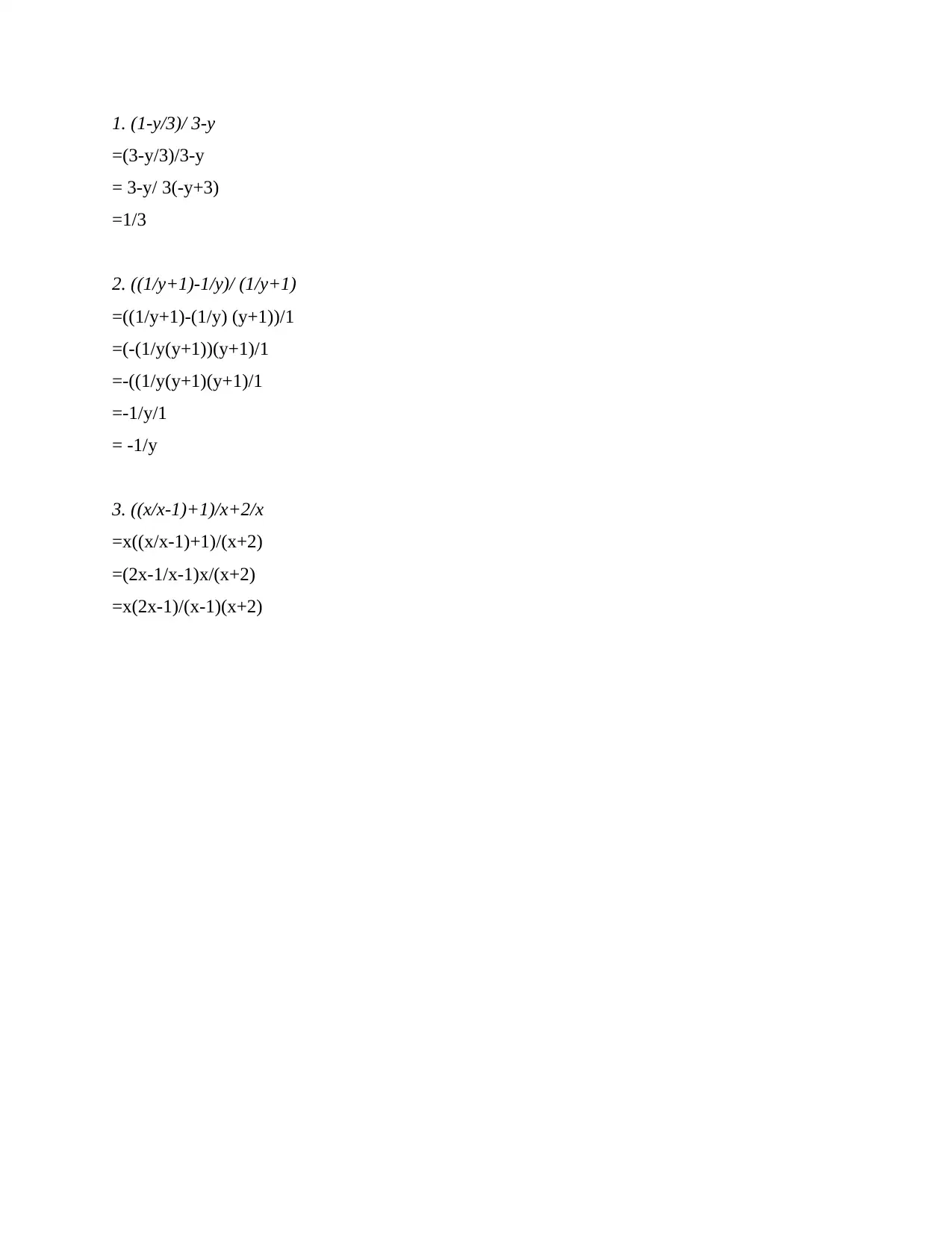
1. (1-y/3)/ 3-y
=(3-y/3)/3-y
= 3-y/ 3(-y+3)
=1/3
2. ((1/y+1)-1/y)/ (1/y+1)
=((1/y+1)-(1/y) (y+1))/1
=(-(1/y(y+1))(y+1)/1
=-((1/y(y+1)(y+1)/1
=-1/y/1
= -1/y
3. ((x/x-1)+1)/x+2/x
=x((x/x-1)+1)/(x+2)
=(2x-1/x-1)x/(x+2)
=x(2x-1)/(x-1)(x+2)
=(3-y/3)/3-y
= 3-y/ 3(-y+3)
=1/3
2. ((1/y+1)-1/y)/ (1/y+1)
=((1/y+1)-(1/y) (y+1))/1
=(-(1/y(y+1))(y+1)/1
=-((1/y(y+1)(y+1)/1
=-1/y/1
= -1/y
3. ((x/x-1)+1)/x+2/x
=x((x/x-1)+1)/(x+2)
=(2x-1/x-1)x/(x+2)
=x(2x-1)/(x-1)(x+2)
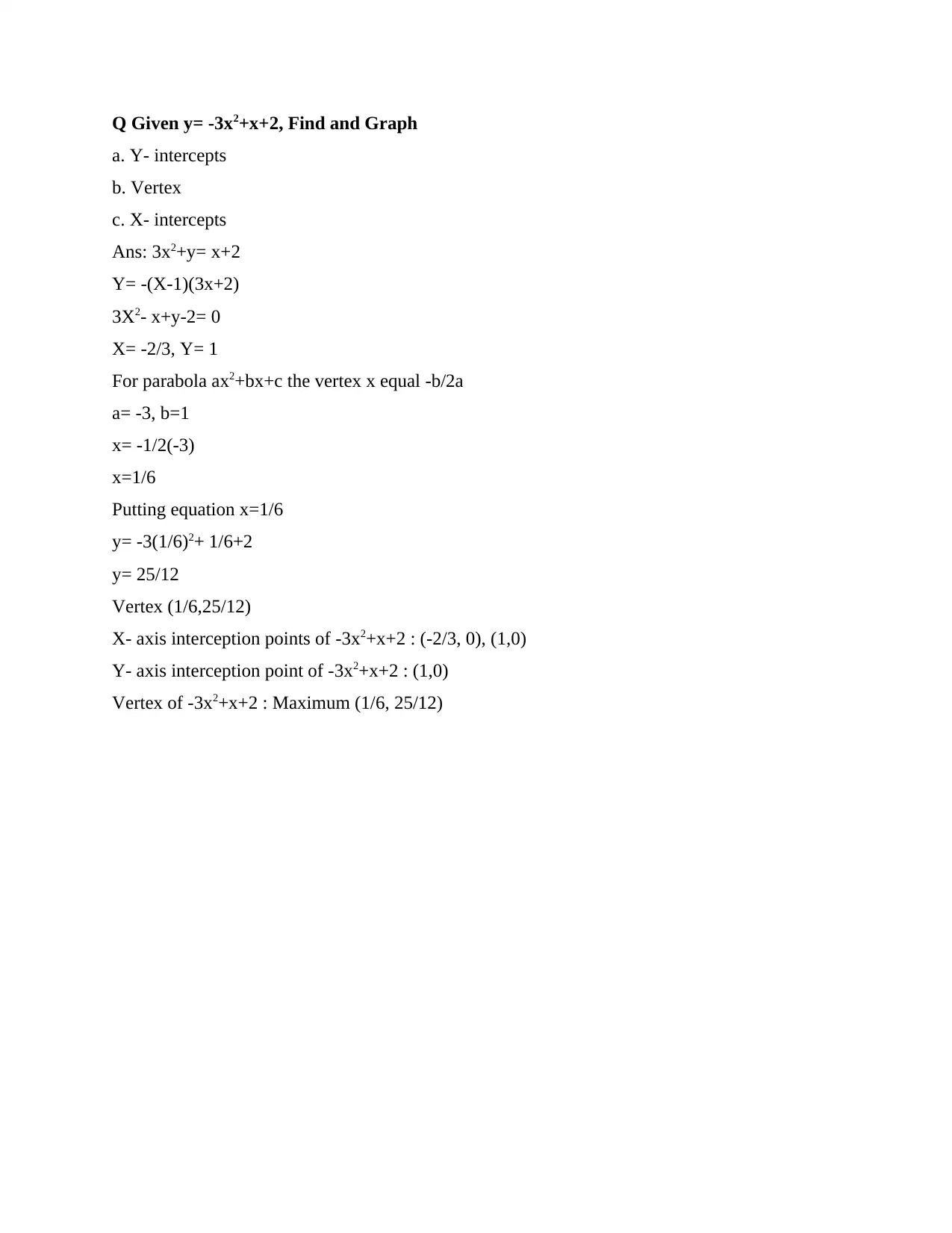
Q Given y= -3x2+x+2, Find and Graph
a. Y- intercepts
b. Vertex
c. X- intercepts
Ans: 3x2+y= x+2
Y= -(X-1)(3x+2)
3X2- x+y-2= 0
X= -2/3, Y= 1
For parabola ax2+bx+c the vertex x equal -b/2a
a= -3, b=1
x= -1/2(-3)
x=1/6
Putting equation x=1/6
y= -3(1/6)2+ 1/6+2
y= 25/12
Vertex (1/6,25/12)
X- axis interception points of -3x2+x+2 : (-2/3, 0), (1,0)
Y- axis interception point of -3x2+x+2 : (1,0)
Vertex of -3x2+x+2 : Maximum (1/6, 25/12)
a. Y- intercepts
b. Vertex
c. X- intercepts
Ans: 3x2+y= x+2
Y= -(X-1)(3x+2)
3X2- x+y-2= 0
X= -2/3, Y= 1
For parabola ax2+bx+c the vertex x equal -b/2a
a= -3, b=1
x= -1/2(-3)
x=1/6
Putting equation x=1/6
y= -3(1/6)2+ 1/6+2
y= 25/12
Vertex (1/6,25/12)
X- axis interception points of -3x2+x+2 : (-2/3, 0), (1,0)
Y- axis interception point of -3x2+x+2 : (1,0)
Vertex of -3x2+x+2 : Maximum (1/6, 25/12)
⊘ This is a preview!⊘
Do you want full access?
Subscribe today to unlock all pages.

Trusted by 1+ million students worldwide
1 out of 17
Related Documents
Your All-in-One AI-Powered Toolkit for Academic Success.
+13062052269
info@desklib.com
Available 24*7 on WhatsApp / Email
![[object Object]](/_next/static/media/star-bottom.7253800d.svg)
Unlock your academic potential
Copyright © 2020–2025 A2Z Services. All Rights Reserved. Developed and managed by ZUCOL.



